NCERT Solutions Class 12 Biology Chapter 5 Molecular Basis of Inheritance have been provided below and is also available in Pdf for free download. The NCERT solutions for Class 12 Biology have been prepared as per the latest syllabus, NCERT books and examination pattern suggested in Class 12 by CBSE, NCERT and KVS. Questions given in NCERT book for Class 12 Biology are an important part of exams for Class 12 Biology and if answered properly can help you to get higher marks. Refer to more Chapter-wise answers for NCERT Class 12 Biology and also download more latest study material for all subjects. Chapter 5 Molecular Basis of Inheritance is an important topic in Class 12, please refer to answers provided below to help you score better in exams
Chapter 5 Molecular Basis of Inheritance Class 12 Biology NCERT Solutions
Students of Class 12 studying Biology are advised to carefully go through the NCERT questions and their detailed answers provided here for the chapter Chapter 5 Molecular Basis of Inheritance. The questions in the NCERT textbook for Class 12 Biology form an important part of school exams. These solutions for Class 12 follow a step-by-step approach and are highly beneficial for exam preparation. Scroll down to view detailed, chapter-wise solutions for Chapter 5 Molecular Basis of Inheritance and explore more NCERT solutions and free study materials for Biology and other subjects of Class 12.
Chapter 5 Molecular Basis of Inheritance NCERT Solutions Class 12 Biology
Question. Group the following as nitrogenous bases and nucleosides:
Adenine, Cytidine, Thymine, Guanosine, Uracil and Cytosine.
Answer. Nitrogenous bases—Adenine, Thymine, Uracil and Cytosine.
Nucleosides—Cytidine and Guanosine.
Question. If a double stranded DNA has 20 per cent of cytosine, calculate the per cent of adenine in the DNA.
Answer. Cytosine = 20%, therefore Guanine = 20%
According to Chargaff’s rule,
A + T = 100 – (G + C)
A + T = 100 – 40. Since both adenine and thymine are in equal amounts,
∴ Thymine = Adenine =60/ 2
=30%
Question. If the sequence of one strand of DNA is written as follows:
5′—ATGCATGCATGCATGCATGCATGCATGC—3′
Write down the sequence of complementary strand in 5′→3′ direction.
Answer. In 3′→5′ direction, 3′—TACGTACGTACGTACGTACGTACGTACG—5′
In 5′→3′ direction, 5′—GCATGCATGCATGCATGCATGCATGCAT—3′
Question. If the sequence of the coding strand in a transcription unit is written as follows:
5′—ATGCATGCATGCATGCATGCATGCATG—3′
Write down the sequence of mRNA.
Answer. 5′—AUGCAUGCAUGCAUGCAUGCAUGCAUG—3′
Question. Which property of DNA double helix led Watson and Crick to hypothesise semi-conservative mode of DNA replication? Explain.
Answer. The two strands of DNA show complementary base pairing. This property of DNA led Watson and Crick to suggest semi-conservative mechanism of DNA replication in which one strand of parent is conserved while the other complementary strand formed is new.
Question. Depending upon the chemical nature of the template (DNA or RNA) and the nature of nucleic acids synthesised from it (DNA or RNA), list the types of nucleic acid polymerases.
Answer. DNA template
(i) DNA polymerase for DNA replication.
(ii) RNA polymerase for RNA synthesis or transcription.
RNA template
(i) RNA-dependent RNA polymerase for synthesis of RNA in some RNA viruses.
(ii) Reverse transcriptase to synthesise cDNA (complementary DNA) over RNA template.
Question. How did Hershey and Chase differentiate between DNA and protein in their experiment
while proving that DNA is the genetic material?
Answer. Procedure:
(i) Some bacteriophage virus were grown on a medium that contained radioactive phosphorus (32P) and some in another medium with radioactive sulphur (35S).
(ii) Viruses grown in the presence of radioactive phosphorus (32P) contained radioactive DNA.
(iii) Similar viruses grown in presence of radioactive sulphur (35S) contained radioactive protein.
(iv) Both the radioactive virus types were allowed to infect E. coli separately.
(v) Soon after infection, the bacterial cells were gently agitated in blender to remove viral coats from the bacteria.
(vi) The culture was also centrifuged to separate the viral particle from the bacterial cell.
- Observations and Conclusions:
(i) Only radioactive 32P was found to be associated with the bacterial cell, whereas radioactive 35S was only found in surrounding medium and not in the bacterial cell.
(ii) This indicates that only DNA and not the protein coat entered the bacterial cell.
(iii) This proves that DNA is the genetic material which is passed from virus to bacteria and not protein.
Question. Differentiate between the following:
(a) Repetitive DNA and satellite DNA
(b) mRNA and tRNA
(c) Template strand and coding strand
Answer. (a) Differences between repetitive DNA and satellite DNA
| Repetitive DNA | Satellite DNA |
| DNA in which certain base sequences are repeated many times are called repetitive DNA. |
DNA in which large portion of the gene is tandemly repeated is called satellite DNA. |
| Repetitive DNA sequences are transcribed. | Satellite DNA sequences are not transcribed. |
(b) Differences between mRNA and tRNA
| mRNA | tRNA |
| It is linear. | It is clover-leaf shaped. |
| It carries coded information. | It carries information for association withan amino acid and an anticodon for its incorporation in a polypeptide. |
| mRNA undergoes additional processing, i.e., capping and tailing, splicing. | It does not require any processing |
| Nitrogen bases are unmodified. | Nitrogen bases may be modified. |
(c) Differences between template strand and coding strand
| Template strand | Coding strand |
| It is the strand of DNA which takes part in transcription. | It is the strand that does not take part in transcription. |
| The polarity is 3′→5′. | The polarity is 5′→3′. |
| Nucleotide sequence is complementary to the one present in mRNA. |
The nucleotide sequence is same as the one present in mRNA except for presence of thymine instead of uracil. |
Question. List two essential roles of ribosome during translation.
Answer. Two essential roles of ribosome during translation are:
(i) One of the rRNA (23S in prokaryotes) acts as a peptidyl transferase ribozyme for formation of peptide bonds.
(ii) Ribosome provides sites for attachment of mRNA and charged tRNAs for polypeptide synthesis.
Question. In the medium where E. coli was growing, lactose was added, which induced the lac operon.
Then, why does lac operon shut down some time after addition of lactose in the medium?
Answer. As lac operon is an inducible operon therefore, it shuts down due to decrease in lactose substrate concentration.
Question. Explain (in one or two lines) the function of the following:
(a) Promoter (b) tRNA (c) Exons
Answer. (a) Promoter: It is the segment of DNA which lies adjacent to the operator and functions as the binding site for RNA polymerase to carry transcription if allowed by operator.
(b) tRNA: It acts as an adaptor molecule that picks up a particular amino acid from cellular pool and takes the same over to A site of mRNA for incorporation into polypeptide chain.
(c) Exons: These are the coding segments present in primary transcript which after splicing are joined to form functional mRNA.
Question.Why is the Human Genome Project called a mega project?
Answer. Human Genome Project is called a mega project because of following reasons:
(i) Sequencing of more than 3 × 109 bp.
(ii) Identification of all the genes present in human genome.
(iii) High expenditure of more than 9 billion dollars.
(iv) Identification of all the alleles of genes and their functions.
(v) Storage of data for sequencing would require space equal to 3300 books of 1000 pages each if each page contains 1000 letters.
Question. What is DNA fingerprinting? Mention its application.
Answer. DNA fingerprinting is the technique to determine the relationship between two DNA samples by studying the similarity and dissimilarity of VNTRs (variable number of tandem repeats). Its applications are:
(i) It is used as a tool in forensic tests to identify criminals.
(ii) To settle paternity disputes.
(iii) To identify racial groups to study biological evolution.
Question. Briefly describe the following:
(a) Transcription (b) Polymorphism
(c) Translation (d) Bioinformatics
Answer.
(a) Transcription: It is the formation of RNA over the template of DNA. It forms single-stranded RNA which has a coded information similar to the sense or coding strand of DNA with the exception that thymine is replaced by uracil. One strand of DNA is used as template strand for the synthesis of a complementary strand of RNA called mRNA.
(b) Polymorphism: Genetic polymorphism means occurrence of genetic material in more than one form. It is of three major types, i.e., allelic, SNP and RFLP.
Allelic polymorphism: Allelic polymorphism occurs due to multiple alleles of a gene. Allele possess different mutations which alter the structure and function of a protein formed by
them as a result, change in phenotype may occur.
SNP or single nucleotide polymorphism: Over 1.4 million single base DNA differences have been observed in human beings. According to SNP, every human being is unique. SNP is very useful for locating alleles, identifying disease-associated sequence and tracing human history.
(c) Translation: It is the process during which the genetic information which is stored in the sequence of nucleotides in an mRNA molecule is converted, following dictations of the genetic code, into the sequence of amino acids in the polypeptide. It takes place in cytoplasm in both eukaryotes and prokaryotes.
(d) Bioinformatics: The science which deals with handling, storing of huge information of genomics as databases, analysing, modelling and providing various aspects of biological information, especially the molecules connected with genomics and proteomics is called bioinformatics.
Following are some applications of bioinformatics:
(i) Phylogeny or evolutionary biology: By comparing gene, nucleotide, protein and amino acid sequence, the organisms are grouped and phylogeny is established.
(ii) Chemoinformatics: Information about chemical combination, their effects, side effects, pharmaceutical chemicals, etc., by databases is done.
(iii) Faster drug research: Analysis of drug–ligand complexes and assessment of binding interaction help in development of computer-aided drug design.
(iv) Proteomics: Protein sequence databases are useful in diagnostics, healthcare and drug research.
NCERT Solutions for Class 12 Biology Chapter 6 Molecular Basis of Inheritance MCQs
Choose and write the correct option in the following questions.
Question. Polysome is formed by
(a) a ribosome with several subunits
(b) ribosomes attached to each other in a linear arrangement
(c) several ribosomes attached to a single mRNA
(d) many ribosomes attached to a strand of endoplasmic reticulum.
Answer. C
Question. The human chromosome with the highest and least number of genes in them are respectively
(a) Chromosome 21 and Y
(b) Chromosome 1 and X
(c) Chromosome 1 and Y
(d) Chromosome X and Y
Answer. C
Question. While analysing the DNA of an organism a total number of 5386 nucleotides were found, out of which the proportion of different bases were: Adenine = 29%, Guanine = 17%, Cytosine = 32%,Thymine = 17%.
Considering the Chargaff’s rule it can be concluded that
(a) it is a double stranded circular DNA
(b) it is single stranded DNA
(c) it is a double stranded linear DNA
(d) no conclusion can be drawn
Answer. B
Question. What is not true for genetic code?
(a) It is nearly universal.
(b) It is degenerate.
(c) It is unambiguous
(d) A codon in mRNAt is read in a non-contiguous fashion.
Answer. D
Question. The net electric charge on DNA and histones is
(a) both positive
(b) both negative
(c) negative and positive, respectively
(d) zero
Answer. C
Question. In the DNA molecule
(a) the proportion of adenine in relation to thymine varies with the organism
(b) there are two strands which run antiparallel—one in 5l " 3l direction and other in 3l " 5l
(c) the total amount of purine nucleotides and pyrimidine nucleotides is not always equal
(d) there are two strands which run parallel in the 5l " 3l direction.
Answer. B
Question. The promoter site and the terminator site for transcription are located at
(a) 3' (downstream) end and 5' (upstream) end, respectively of the transcription unit
(b) 5' (upstream) end and 3' (downstream) end, respectively of the transcription unit
(c) the 5' (upstream) end
(d) the 3' (downstream) end
Answer. B
Question. Control of gene expression in prokaryotes take place at the level of
(a) DNA-replication
(b) Transcription
(c) Translation
(d) None of the above
Answer. B
Question. Which of the following statements is the most appropriate for sickle cell anaemia?
(a) It cannot be treated with iron supplements
(b) It is a molecular disease
(c) It confers resistance to acquiring malaria
(d) All of the above
Answer. D
Question. With regard to mature mRNA in eukaryotes
(a) exons and introns do not appear in the mature RNA
(b) exons appear but introns do not appear in the mature RNA
(c) introns appear but exons do not appear in the mature RNA
(d) both exons and introns appear in the mature RNA
Answer. D
Question. Who amongst the following scientists had no contribution in the development of the double helix model for the structure of DNA?
(a) Rosalind Franklin
(b) Maurice Wilkins
(c) Erwin Chargaff
(d) Meselson and Stahl
Answer. D
Question. Gene controls
(a) protein synthesis but not heredity
(b) protein synthesis and heredity
(c) heredity but not protein synthesis
(d) biochemical reaction of some enzymes
Answer. B
Question. DNA is a polymer of nucleotides which are linked to each other by 3′→ 5′ phosphodiester bond. To prevent polymerisation of nucleotides, which of the following modifications would you choose?
(a) Replace purine with pyrimidines
(b) Remove/replace 3' OH group in deoxyribose
(c) Remove/replace 2' OH group with some other group in deoxyribose
(d) Both ‘b’ and ‘c’
Answer. D
Question. In E.coli, the lac operon gets switched on when
(a) lactose is present and it binds to the repressor
(b) repressor binds to operator
(c) RNA polymerase binds to the operator
(d) lactose is present and it binds to RNA polymerase
Answer. A
Question. Discontinuous synthesis of DNA occurs in one strand, because
(a) DNA molecule being synthesised is very long
(b) DNA dependent DNA polymerase catalyses polymerisation only in one direction (5′ → 3′)
(c) it is a more efficient process
(d) DNA ligase joins the short stretches of DNA
Answer. B
Question. Amino acid sequence, in protein synthesis is decided by the sequence of
(a) rRNA
(b) tRNA
(c) mRNA
(d) cDNA
Answer. C
Question.If Meselson and Stahl's experiment is continued for four generations in bacteria, the ratio of N15/N15: N15/N14: N14/N14 containing DNA in the fourth generation would be
(a) 1:1:0
(b) 1:4:0
(c) 0:1:3
(d) 0:1:7
Answer. D
Question. Antiparallel strands of a DNA molecule means that
(a) one strand turns clockwise
(b) one strand turns anti-clockwise
(c) the phosphate groups of two DNA strands, at their ends, share the same position
(d) the phosphate groups at the start of two DNA strands are in opposite position (pole).
Answer. D
Question. Which of the following steps in transcription is catalysed by RNA polymerase?
(a) Initiation
(b) Elongation
(c) Termination
(d) All of the above
Answer. B
Question. Which of the following statements is correct about the role of regulatory proteins in transcription in prokaryotes?
(a) They only increase expression
(b) They only decrease expression
(c) They interact with RNA polymerase but do not affect the expression
(d) They can act both as activators and as repressors
Answer. D
Question. Removal of introns and joining the exons in a defined order in a transcription unit is called
(a) tailing
(b) transformation
(c) capping
(d) splicing
Answer. D
Question. Which of the following are the functions of RNA?
(a) It is a carrier of genetic information from DNA to ribosomes synthesising polypeptides.
(b) It carries amino acids to ribosomes.
(c) It is a constituent component of ribosomes.
(d) All of the above.
Answer. D
Question. In some viruses, DNA is synthesised by using RNA as template. Such a DNA is called
(a) A-DNA
(b) B-DNA
(c) cDNA
(d) rDNA
Answer. C
Question. If the sequence of nitrogen bases of the coding strand of DNA in a transcription unit is: 5' - A T G A A T G - 3', the sequence of bases in its RNA transcript would be
(a) 5' - A U G A A U G - 3'
(b) 5' - U A C U U A C - 3'
(c) 5' - C A U U C A U - 3'
(d) 5' - G U A A G U A - 3'
Answer. A
Question. Which was the last human chromosome to be completely sequenced?
(a) Chromosome 1
(b) Chromosome 11
(c) Chromosome 21
(d) Chromosome X
Answer. A
NCERT Solutions for Class 12 Biology Chapter 6 Molecular Basis of Inheritance Assertion-Reason Questions
In the following questions a statement of assertion followed by a statement of reason is given. Choose the correct answer out of the following choices.
(a) Assertion and reason both are correct statements and reason is correct explanation for assertion.
(b) Assertion and reason both are correct statements but reason is not correct explanation for assertion.
(c) Assertion is correct statement but reason is wrong statement.
(d) Assertion is wrong statement but reason is correct statement.
Question. Assertion : DNA replication is semiconservative in nature.
Reason : In each cycle of replication the complementary strands of parental double helix is conserved.
Answer. A
Question. Assertion : mRNA attaches to ribosome through its 5' end.
Reason : The mRNA has bases of lagging sequence.
Answer. C
Question. Assertion : Histones are basic proteins of major importance in packaging of eukaryotic DNA, DNA and histones comprise chromatin forming the bulk of eukaryotic chromosome.
Reason : Histones are of five major types: H1, H2A, H2B, H3 and H4.
Answer. B
Question. Assertion : Replication and transcription occur in the nucleus but translation occurs in the cytoplasm.
Reason : mRNA is transferred from the nucleus into the cytoplasm where ribosomes and amino acids are available for protein synthesis.
Answer. A
Question. Assertion : The human genome comprise of a large amount of repetitive sequences.
Reason : The repetitive sequences in the genome do not have direct coding functions.
Answer. B
Question. Assertion : Eukaryotic mRNA requires post-transcriptional modifications to form functional mRNA.
Reason : Eukaryotic transcripts possess extra non-functional gene segments called introns.
Answer. A
Question. Assertion : In Griffith's experiment, the mixture of heat-killed virulent R bacteria and live nonvirulent S bacteria, lead to the death of mice.
Reason : The transforming principle got transferred from S strain to heat-killed R strain and made it virulent.
Answer. D
Question. Assertion : DNA is considered to be a better genetic material than RNA for most organisms.
Reason : 2'–OH group present in DNA makes it less reactive.
Answer. C
Question. Assertion : The tRNA molecules possess anticodons.
Reason : It needs the message in form of codons.
Answer. B
Question. Assertion : Lac operon is a repressible operon.
Reason : The product of repressor binds to the operator and prevents expression of the said gene.
Answer.D
NCERT Solutions for Class 12 Biology Chapter 6 Molecular Basis of Inheritance Case-based/Source-based Question
1. Study the schematic representation of the genes involved in the lac operon given below and answer the questions that follow:
p i p o z y a
Question. Sometimes cattle or even human beings give birth to their young ones that have extremely different sets of organs like limbs/position of eye(s), etc. Why?
Answer. This is due to a disturbance in coordinated regulation of expression of sets of genes associated with organ development or due to mutations.
Question. What will prevent the binding of the molecule ‘M’ with the operator gene? Mention the event that follows.
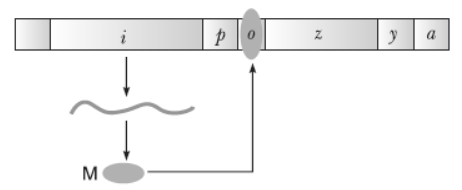
Answer. An inducer prevents the binding of repressor to operator and starts transcription i.e., lactose here.
Question. A region of a coding DNA strand has the following nucleotide sequence:
– A T G C –
What shall be the nucleotide sequence in (a) sister DNA segment it replicates, and (b) m-RNA polynucleotide it transcribes?
Answer.
(a) – TACG –
(b) – UACG –
2. Study the figure given below and answer the questions:
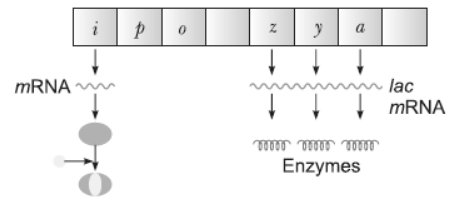
Question. How does the repressor molecule get inactivated?
Answer. When the inducer comes in contact with repressor, it is inactivated.
Question. When does the transcription of lac mRNA stop?
Answer. When lactose is lacking or absent, the transcription of lac mRNA stops.
Question. Name the enzyme transcribed by the gene ‘z’.
Answer. β-galactosidase.
3. Observe the diagram of the polynucleotide chain and answer the questions.
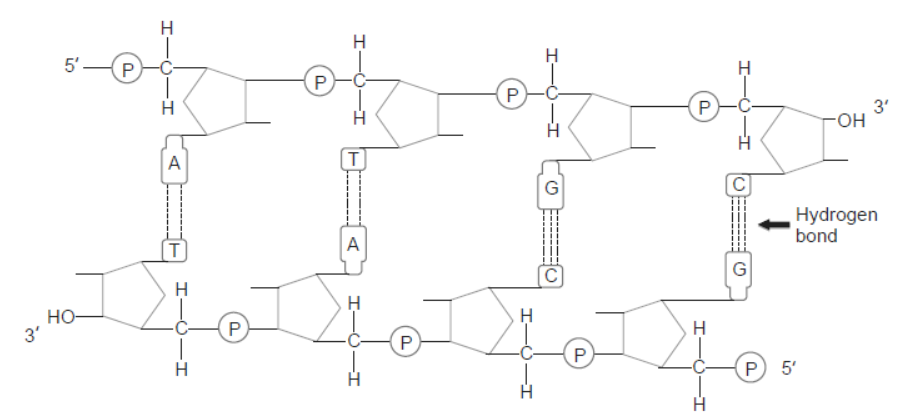
Question. The fact that a purine base always pairs through hydrogen bonds with a pyrimidine base in the DNA double helix leads to
(a) the antiparallel nature
(b) the semiconservative nature
(c) uniform width throughout DNA
(d) uniform length in all DNA
Answer. C
Question. How does the flow of genetic information in HIV deviate from the ‘Central dogma’ proposed by Francis Crick?
Answer. In HIV single stranded RNA is converted to double stranded DNA.
Question. Write the role of histone protein in packaging of DNA in eukaryotes.
Answer. Histones are positively charged basic proteins. The negatively charged DNA is wrapped around the positively charged histone octamer to form nucleosome
4. Given below is the diagram of a tRNA molecule.
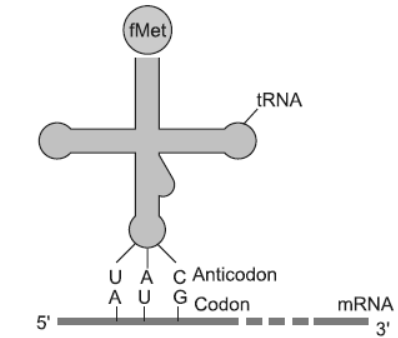
Answer the questions based on the above diagram:
Question. Why is charging of tRNA essential in translation?
Answer. Charging of tRNA is essential for ribosome to recognise it and convert the genetic code into protein.
Question. Where does peptide bond formation occur in a bacterial ribosome?
Answer. Peptide bond formation takes place in the ribosome.
Question. Name the scientist who called tRNA an adaptor molecule.
Answer. Francis Crick
5. Watson-Crick gave the semi-conservative mode of DNA replication.
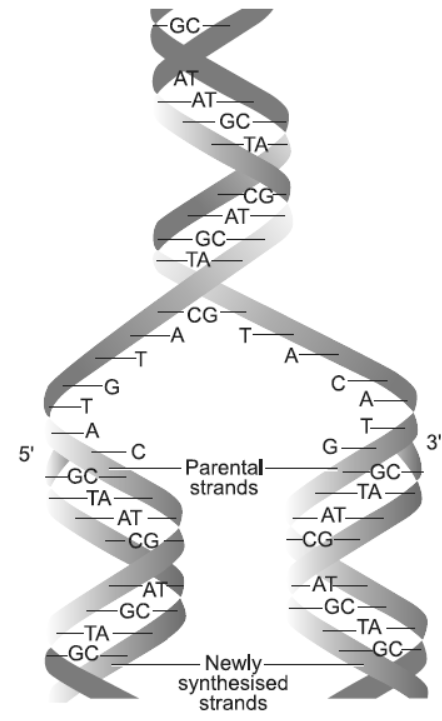
Answer the questions based on the given diagram:
Question. In a nucleus, the number of RNA nucleoside triphosphates is 10 times more than the number of DNA nucleoside triphosphates, still only DNA nucleotides are added during the DNA replication, and not the RNA nucleotides. Why?
Answer.
DNA polymerase is highly specific to recognise only deoxyribonucleoside triphosphates.
Therefore it cannot hold RNA nucleotides.
Question. Name the enzyme and state its property that is responsible for continuous and discontinuous replication of the two strands of a DNA molecule.
Answer. DNA dependent DNA polymerase. It catalyses polymerisation in 5′ → 3′ direction only.
Question. Name the enzyme involved in the continuous replication of DNA strand. Mention the polarity of the template strand.
Answer. DNA polymerase is involved in continuous replication of DNA strand. The polarity of template strand is 3′ → 5′.
NCERT Solutions for Class 12 Biology Chapter 6 Molecular Basis of Inheritance Long Answer Questions
Question. Describe the elongation process of transcription in bacteria.
Answer. After initiation, RNA polymerase loses the s factor but continues the polymerisation of ribonucleotides to form RNA. It uses nucleoside triphosphates as substrate and polymerises in a template-dependent fashion, following the rule of complementarity.
Question. Describe the termination process of transcription in bacteria.
Answer. Once the RNA polymerase reaches the termination region of DNA, the RNA polymerase is separated from DNA–RNA hybrid, as a result nascent RNA separates. This process is facilitated by a termination factor r (rho). In prokaryotes, mRNA does not require any processing, so transcription and translation both occur in the cytosol.
Question. How is hnRNA processed to form mRNA?
Answer. The hnRNA undergoes the following processes to form mRNA:
(i) Capping: Addition of methyl guanosine triphosphate at 5’-end.
(ii) Tailing: Addition of 200-300 adenylate residues at 3’-end.
(iii) Splicing: Removal of introns and rejoining of exons.
Question. What is hnRNA? Explain the changes hnRNA undergoes during its processing to form mRNA.
Answer. hnRNA is the precursor of mRNA that is transcribed by RNA ploymerase II and is called heterogenous nuclear RNA.
Changes:
- The hnRNA undergoes two additional processes called capping and tailing.
- In capping, an unusual nucleotide, methyl guanosine triphosphate, is added to the 5’-end of hnRNA.
- In tailing, adenylate residues (about 200–300) are added at 3’-end in a template independent manner.
- Now the hnRNA undergoes a process where the introns are removed and exons are joined to form mRNA by the process called splicing.
- Fragments on one of the template strands.
Question. (a) Identify the polarity from a to a′ in the given diagram and mention how many more amino acids are expected to be added to this polypeptide chain.
(b) Mention the DNA sequence coding for serine and the anticodon of tRNA for the same amino acid.
(c) Why are some untranslated sequence of bases seen in mRNA coding for a polypeptide?
Where exactly are they present on mRNA?
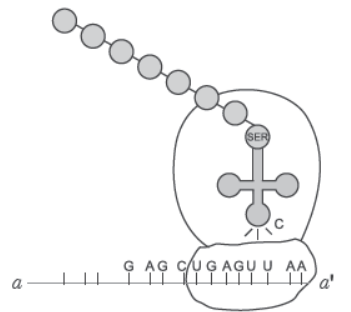
Answer. (a) Polarity from a to a' is 5'→ 3'.
No more amino acid will be added to this polypeptide chain.
(b) TCA; anticodon is UCA.
(c) The untranslated sequence of bases are required for efficient translation process. They are present before the start codon at the 5'-end and after the stop codon at 3'-end.
Question. One of the codons on mRNA is AUG. Draw the structure of tRNA adapter molecule for this codon. Explain the uniqueness of this tRNA.
Answer. This tRNA is specific for amino acid Methionine and it also acts as initiator codon (initiator tRNA)
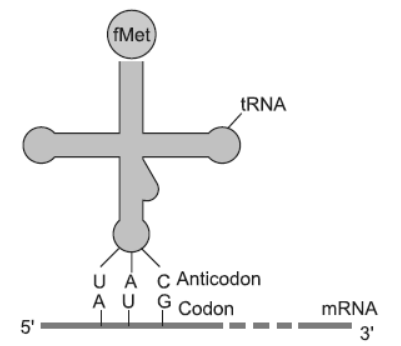
Question. Explain the process of translation in a bacterium.
Answer.
- Translation is the process of synthesis of protein from amino acids, sequence and order of amino acids being defined by sequence of bases inm RNA. Amino acids are joined by peptide bonds.
- A translational unit in mRNA from 5' → 3' comprises of a start codon, region coding for a polypeptide, a stop codon and untranslated regions (UTRs). UTRs are additional sequences of mRNA that are not translated. They are present at both 5' end (before start codon) and at 3' end (after stop codon) for efficient translation process.
Question. How is the translation of mRNA terminated? Explain.
Answer.
- When the A-site of ribosome reaches a termination codon, which does not code for any amino acid, no charged tRNA binds to the A-site.
- Dissociation of polypeptide from ribosome takes place, which is catalysed by a ‘release factor’.
- There are three termination codons namely UGA, UAG and UAA.
Question. Unambiguous, universal and degenerate are some of the terms used for the genetic code.
Explain the salient features of each one of them.
Answer. Unambiguous code means that one codon codes for only one amino acid, e.g., AUG codes for only methionine.
Universal code means that codon and its corresponding amino acid are the same in all organisms,e.g., from bacteria to human, UUU codes for phenylalanine.
Degenerate code means that same amino acids are coded by more than one codon, e.g., UUU and UUC code for phenylalanine.
Question. State the conditions when ‘genetic code’ is said to be
(i) degenerate,
(ii) unambiguous and specific,
(iii) universal.
Answer. (i) Degenerate—When some amino acids are coded by more than one amino acids.
(ii) Unambiguous and specific—When one codon codes for only one specific amino acid.
(iii) A particular codon codes for same amino acid in all organisms except in mitochondria and few protozoa.
Question. (a) Draw the structure of the initiator tRNA adaptor molecule.
(b) Why is tRNA called an adaptor molecule?
Answer.
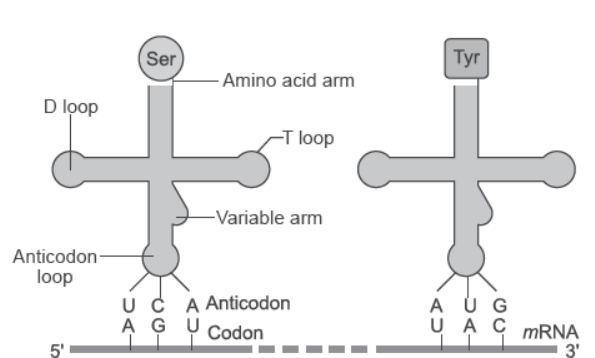
(b) tRNA is called an adaptor molecule because on one end it reads the code on mRNA and on other end it would bind to the amino acid corresponding to the anticodon.
Question.

Study the mRNA segment given above which is complete to be translated into a polypeptide chain.
(i) Write the codons ‘a’ and ‘b’.
(ii) What do they code for?
(iii) How is peptide bond formed between two amino acids in the ribosome?
Answer. (i) a is AUG and b is UAA/UAG/UGA
(ii) AUG codes for methionine (initiation codon).
UAA/UAG/UGA do not code for any amino acid, i.e., stop or terminating codons.
(iii) There are two sites (P-site and A-site) in the large subunit of ribosome, where subsequent amino acids bind to and thus are close enough to form peptide bond by peptidyl transferase enzyme. The ribosome also acts as a catalyst for the formation of peptide bond.
Question. “The codon is a triplet and is read in a contiguous manner without punctuations.” Provide the genetic basis for the statement.
Answer. Since there are only four bases which code for twenty amino acids, the code should be made up of three bases, i.e., (4 × 4 × 4) = 64 codons; a number more than the required.
If the codon consists of four letters, only (4 × 4), only sixteen codons are possible, which is less than the required. Hence the codon is a triplet.
As the ribosome moves on mRNA, continuously without break, the codons are read in a contiguous manner.
Question. Identify giving reasons, the salient features of genetic code by studying the following nucleotide sequence of mRNA strand and the polypeptide translated from it.
AUG UUU UCU UUU UUU UCU UAG
Met – Phe – Ser – Phe – Phe – Ser
Answer.
| Salient features of genetic code | Reason |
| The codon is a triplet. | e.g., AUG, UUU, etc, are triplets |
| One codon codes for only one amino acid, hence it is unambiguous and specific | e.g., UUU codes for serine, AUG for methionine, etc. |
| AUG has dual function as it codes for methionine and it also acts as initiator codon. |
AUG is seen at the beginning of the polypeptide chain. |
| UAG does not code for any amino acid hence is called stop codon and leads to end of translation. | No amino acid is coded by UAG in the polypeptide chain given. |
Question. (a) Name the molecule ‘X’ synthesised by ‘i’ gene. How does this molecule get inactivated?
(b) Which one of the structural genes codes for β-galactosidase?
(c) When will the transcription of this gene stop?
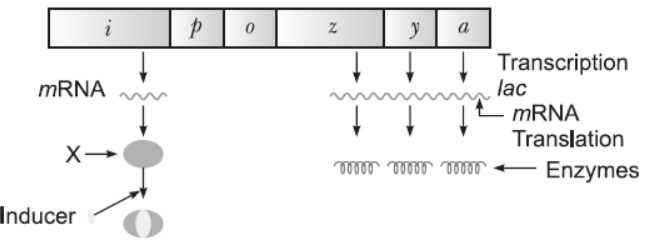
Answer. (a) The molecule ‘X’ is repressor. It gets inactivated when lactose (inducer) binds with the repressor molecule.
(b) z gene codes for β-galactosidase.
(c) Transcription of the gene stops when lactose is absent and thus repressor is free to bind with the operator.
Question. Draw a schematic diagram of lac operon in its ‘switched off’ position. Label the following:
(i) The structural genes (ii) Repressor bound to its correct position
(iii) Promoter gene (iv) Regulatory gene.
Answer.

(i) z, y and a are structural genes.
(iii) p is the promoter sequence.
(iv) i is the regulatory gene.
Question. (a) What do ‘Y’and ‘B’ stand for in ‘YAC’ and ‘BAC’ used in Human Genome Project (HGP).
Mention their role in the project.
(b) Write the percentage of the total human genome that codes for proteins and the percentage of discovered genes whose functions are known as observed during HGP.
(c) Expand ‘SNPs’ identified by scientists in HGP.
Answer. (a) ‘Y’ stands for Yeast and ‘B’ stands for Bacterial.
‘YAC’ and ‘BAC’ are used as vectors for cloning foreign DNA.
(b) The total human genome percentage is (<) 2% and percentage of discovered genes is (<) 50%.
(c) Single Nucleotide Polymorphism.
Question. (a) Explain DNA polymorphism as the basis of genetic mapping of human genome.
(b) State the role of VNTR in DNA fingerprinting.
Answer. (a) Genetic polymorphism means occurrence of genetic material in more than one form. It is of three major types, i.e., allelic, SNP and RFLP.
Allelic polymorphism: Allelic polymorphism occurs due to multiple alleles of a gene. Allele possess different mutations which alter the structure and function of a protein formed by them as a result, change in phenotype may occur.SNP or single nucleotide polymorphism: SNP is very useful for locating alleles, identifying disease-associated sequence and tracing human history.
(b) Variable Number Tandem Repeats (VNTRs) are used in DNA fingerprinting as markers. VNTRs vary from person to person and are inherited from one generation to the next.
Therefore, only closely related individuals have similar VNTRs.
Question. How are the DNA fragments separated and isolated for DNA fingerprinting? Explain.
Answer. Separation and Isolation of DNA Fragments (Gel Electrophoresis)
- Gel electrophoresis is a technique for separating DNA fragments based on their size.
- Firstly, the sample DNA is cut into fragments by restriction endonucleases.
- The DNA fragments being negatively charged can be separated by forcing them to move towards the anode under an electric field through a medium/matrix.
- Commonly used matrix is agarose, which is a natural linear polymer of D-galactose and 3, 6-anhydro-L-galactose which is extracted from sea weeds.
- The DNA fragments separate-out (resolve) according to their size because of the sieving property of agarose gel. Hence, the smaller the fragment size, the farther it will move.
- The separated DNA fragments are visualised after staining the DNA with ethidium bromide followed by exposure to UV radiation.
- The DNA fragments are seen as orange coloured bands.
- The separated bands of DNA are cut out and extracted from the gel piece. This step is called elution.
- The purified DNA fragments are used to form recombinant DNA which can be joined with cloning vectors.
Question. Forensic department was given three blood samples. Write the steps of the procedure carried to get the DNA fingerprinting done for the above samples.
Answer. Methodology and Technique
(i) DNA is isolated and extracted from the cell or tissue by centrifugation.
(ii) By the process of polymerase chain reaction (PCR), many copies are produced. This step is called amplification.
(iii) DNA is cut into small fragments by treating with restriction endonucleases.
(iv) DNA fragments are separated by agarose gel electrophoresis.
(v) The separated DNA fragments are visualised under ultraviolet radiation after applying suitable dye.
(vi) The DNA is transferred from electrophoresis plate to nitrocellulose or nylon membrane sheet.This is called Southern blotting.
(vii) VNTR probes are now added which bind to specific nucleotide sequences that are complementary to them. This is called hybridisation.
(viii) The hybridised DNA fragments are detected by autoradiography. They are observed as dark bands on X-ray film.
(ix) These bands being of different sizes, give a characteristic pattern for an individual DNA. It differs from individual to individual except in case of monozygotic (identical) twins.
Question. Write any six salient features of the human genome as drawn from the human genome project.
Answer. Salient Features of Human Genome
(i) The human genome contains 3164.7 million nucleotide bases.
(ii) The average gene consists of 3000 bases; the largest known human gene being dystrophin at 2.4 million bases.
(iii) The total number of genes is estimated to be 30,000 and 99.9 per cent nucleotide bases are exactly the same in all people.
(iv) The functions are unknown for over 50 per cent of the discovered genes.
(v) Less than 2 per cent of the genome codes for proteins.
(vi) The human genome contains large repeated sequences, repeated 100 to 1000 times.
(vii) The repeated sequence is thought to have no direct coding functions but they throw light on chromosome structures, dynamics and evolution.
(viii) Chromosome 1 has most genes (2968) and the Y has the fewest genes (231).
(ix) Scientists have identified about 1.4 million locations where single base DNA sequence differences called SNPs or single nucleotide polymorphism (pronounced as ‘snips’) occur in humAnswer.This information promises to revolutionise the processes of finding chromosomal locations for disease—associated sequences and tracing human history.
Rice Genome Project
- The International Rice Genome Sequencing Project (IRGSP) began in September 1997, at a workshop held in conjunction with the International Symposium on Plant Molecular Biology in Singapore.
- Rice genome sequencing is being conducted along the same lines as numerous other large-scale genome sequencing projects. Large insert genomic libraries, used as the primary sequencing templates, are constructed in bacterial artificial chromosomes (BACs).
- One of the initial motivators for sequencing rice, besides the relatively small genome size, was that it could be used as a model for other cereal crops with larger genomes, such as maize and wheat. This was predicated somewhat on rice’s small genome size and the realization from molecular mapping,e.g., RFLPs, of conserved markers and marker order.
- The availability of the rice genome, together with the community annotation and other resources that added functionality, transformed genetics research and rice breeding.
Question. “A very small sample of tissue or even a drop of blood can help determine paternity”. Provide a scientific explanation to substantiate the statement.
Answer. (i) DNA from all cells of an individual shows the same degree of polymorphism and therefore becomes a useful identification tool.
(ii) Polymorphs are heritable and the child inherits 50% of the chromosome from each parent.
(iii) With the help of PCR the small amount of DNA from blood can be amplified and be used in DNA finger printing to identify the paternity.
Question.

(a) Identify strands ‘A’ and ‘B’ in the diagram of transcription unit given above and write the basis on which you identified them.
(b) Write the functions of RNA polymerase-I and RNA polymerase-III in eukaryotes.
Answer. (a) A—Template strand
B—Coding strand
The templates are identified on the basis of polarity with respect to promoter. Template strand has polarity 3′ → 5′ and coding strand has polarity 5′ → 3′.
(b) RNA polymerase-I transcribes rRNAs.
RNA polymerase-III transcribes tRNA, 5srRNA and snRNA.
| NCERT Solutions Class 12 Biology Chapter 2 Sexual Reproduction in Flowering Plants |
| NCERT Solutions Class 12 Biology Chapter 3 Human Reproduction |
| NCERT Solutions Class 12 Biology Chapter 4 Reproductive Health |
| NCERT Solutions Class 12 Biology Chapter 5 Principles of Inheritance and Variation |
| NCERT Solutions Class 12 Biology Chapter 6 Molecular Basis of Inheritance |
| NCERT Solutions Class 12 Biology Chapter 7 Evolution |
| NCERT Solutions Class 12 Biology Chapter 8 Human Health and Disease |
| NCERT Solutions Class 12 Biology Chapter 10 Microbes in Human Welfare |
| NCERT Solutions Class 12 Biology Chapter 11 Biotechnology Principles And Processes |
| NCERT Solutions Class 12 Biology Chapter 12 Biotechnology and its Applications |
| NCERT Solutions Class 12 Biology Chapter 13 Organisms and Populations |
| NCERT Solutions Class 12 Biology Chapter 14 Ecosystem |
| NCERT Solutions Class 12 Biology Chapter 15 Biodiversity and Conservation |
NCERT Solutions Class 12 Biology Chapter 5 Molecular Basis of Inheritance
The above provided NCERT Solutions Class 12 Biology Chapter 5 Molecular Basis of Inheritance is available on our website for free download in Pdf. You can read the solutions to all questions given in your Class 12 Biology textbook online or you can easily download them in pdf. The answers to each question in Chapter 5 Molecular Basis of Inheritance of Biology Class 12 has been designed based on the latest syllabus released for the current year. We have also provided detailed explanations for all difficult topics in Chapter 5 Molecular Basis of Inheritance Class 12 chapter of Biology so that it can be easier for students to understand all answers. These solutions of Chapter 5 Molecular Basis of Inheritance NCERT Questions given in your textbook for Class 12 Biology have been designed to help students understand the difficult topics of Biology in an easy manner. These will also help to build a strong foundation in the Biology. There is a combination of theoretical and practical questions relating to all chapters in Biology to check the overall learning of the students of Class 12.
You can download the NCERT Solutions for Class 12 Biology Chapter 5 Molecular Basis of Inheritance for latest session from StudiesToday.com
Yes, the NCERT Solutions issued for Class 12 Biology Chapter 5 Molecular Basis of Inheritance have been made available here for latest academic session
Regular revision of NCERT Solutions given on studiestoday for Class 12 subject Biology Chapter 5 Molecular Basis of Inheritance can help you to score better marks in exams
Yes, studiestoday.com provides all latest NCERT Chapter 5 Molecular Basis of Inheritance Class 12 Biology solutions based on the latest books for the current academic session
Yes, NCERT solutions for Class 12 Chapter 5 Molecular Basis of Inheritance Biology are available in multiple languages, including English, Hindi
All questions given in the end of the chapter Chapter 5 Molecular Basis of Inheritance have been answered by our teachers

